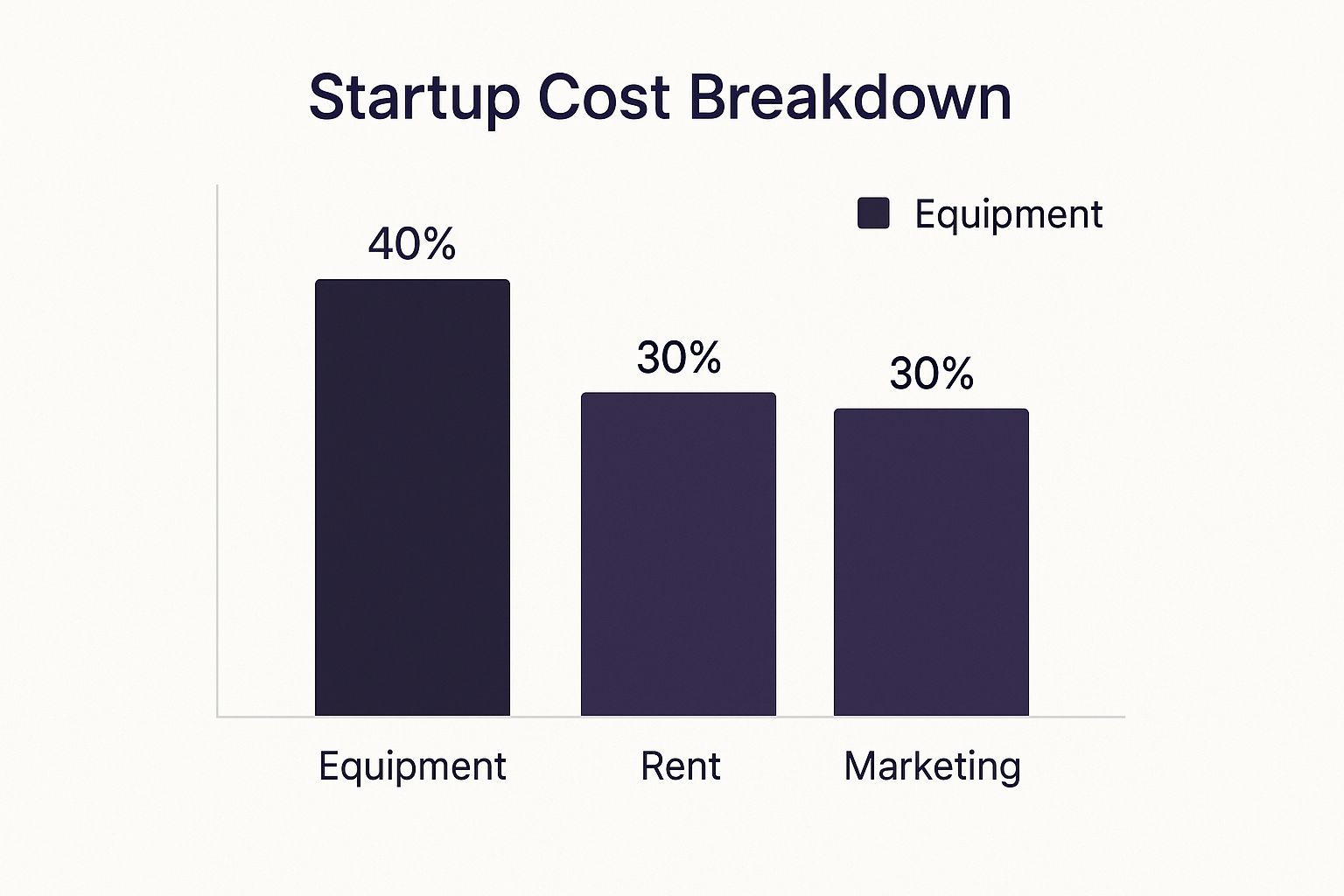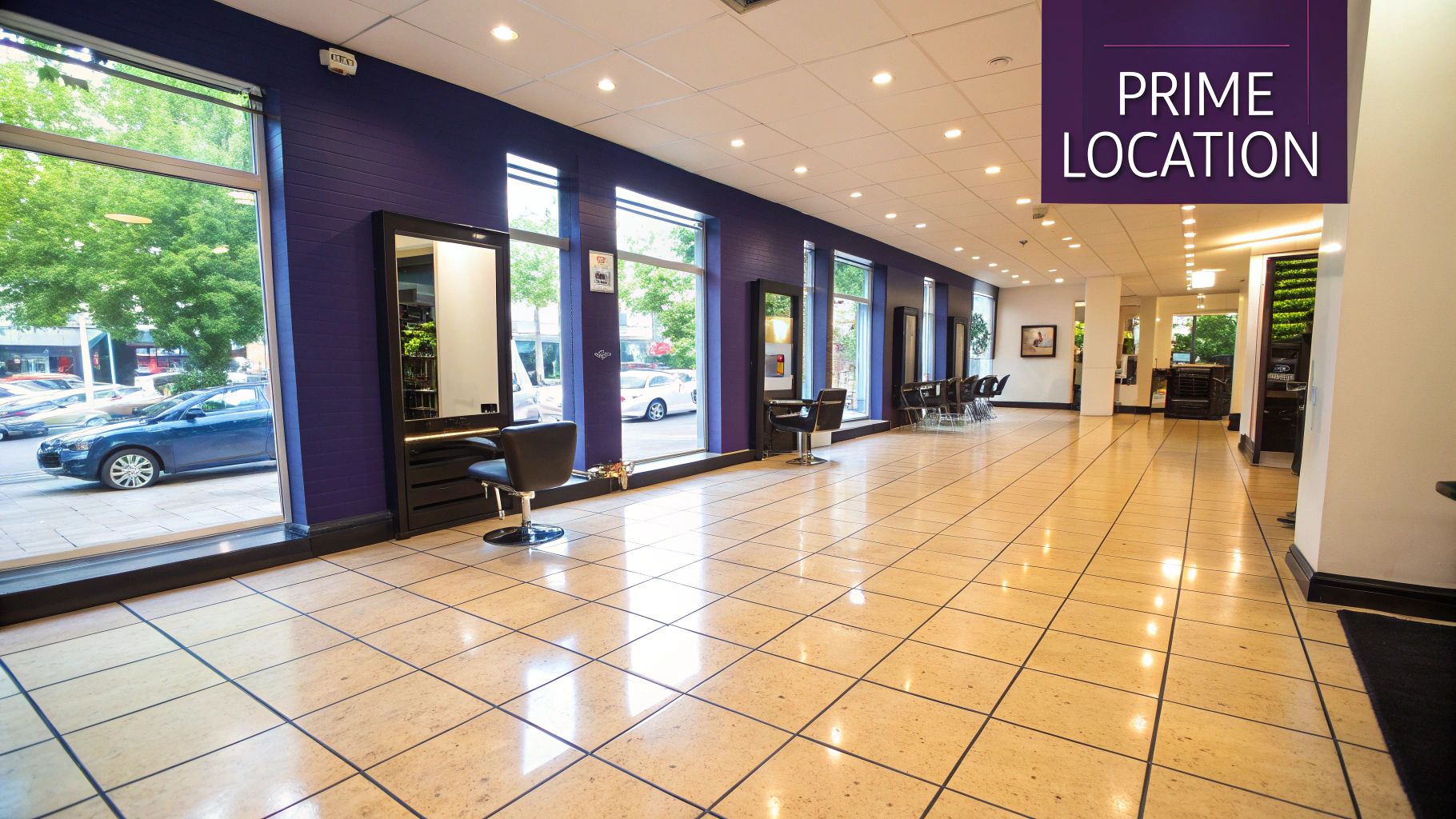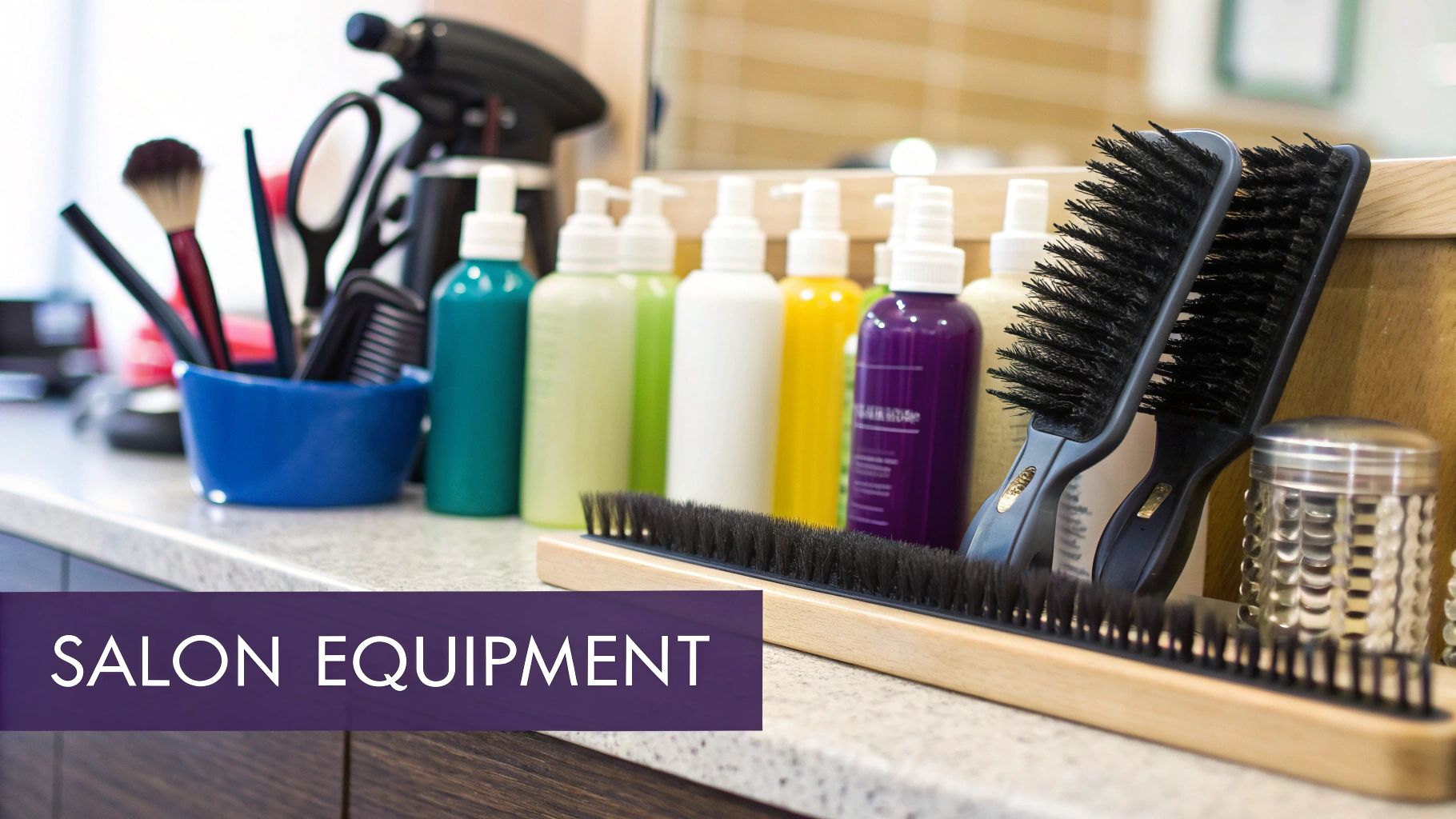How to Open a Salon: An Entrepreneur’s Actionable Guide

Opening a salon begins with a vision, but it becomes a reality with a rock-solid business plan. This isn't just about jotting down ideas; it's a step-by-step roadmap detailing your unique brand, your ideal clients, and your financial strategy.
This document is what transforms your passion into a fundable, sustainable business—the kind that lenders and investors want to support. Nailing this plan is your first actionable step toward launching a successful beauty empire.
Crafting a Salon Business Plan That Gets Funded
Before buying a single pair of scissors or choosing a paint color, create your business plan. Treat this as your personal guide for every critical decision you'll make, not just a formality for the bank.
Think of it as the blueprint for your entire operation. A well-researched plan proves you’ve considered every angle, from your brand's unique vibe to your long-term profitability.
The heart of your plan is defining what makes your salon special. Are you launching a chic, minimalist blowout bar for busy professionals? A cozy, family-friendly spot that becomes a neighborhood staple? Or a high-end luxury spa with a full menu of wellness services? Pinpointing this identity early on will guide every subsequent step.
Define Your Unique Salon Concept
Your salon concept is your unique selling proposition (USP). It’s the clear answer to the question, "Why would someone choose my salon over others?" Be specific and avoid generic descriptions.
- Action Step 1: Choose a Niche. Will you be the go-to expert for curly hair, intricate nail art, organic skincare, or express services? A focused niche attracts a loyal client base.
- Action Step 2: Identify Your Target Audience. Who is your ideal client? Is it the budget-conscious college student, the affluent professional seeking premium treatments, or the modern man needing top-notch grooming?
- Action Step 3: Define Your Brand Atmosphere. Describe the feeling clients get when they walk in. Is it high-energy and social, calm and serene, or edgy and artistic? Write down three words that capture this feeling.
Conduct Actionable Market Research
Once you know who you are, you must understand your local market. Market research isn't about collecting data; it's about spotting opportunities.
Start by analyzing local competitors. Visit their websites, read their Google reviews (good and bad), and consider booking a small service to experience their client journey firsthand.
Look for gaps in the market. Is every salon focused on high-end color, creating an opening for an affordable, high-quality cutting salon? Does no one offer late-night appointments for the 9-to-5 crowd? These service gaps are opportunities for your new business.
Your business plan should tell a compelling story about a specific problem in the market and how your salon is the perfect solution. It's about showing you've identified a real need and have a clear strategy to fill it.
Build Confidence with Financial Projections
This is the section where investors and lenders pay close attention. Your financial projections must be both ambitious enough to be exciting and realistic enough to be believable.
Break your financials into three key areas:
- Startup Costs: Create a detailed spreadsheet of every single expense required to open your doors. Include salon chairs, shampoo bowls, your initial product order, and the lease security deposit. Don't omit anything.
- Monthly Operating Expenses: Calculate your monthly costs. This includes fixed costs like rent and salaries, plus variable costs like utilities, marketing, credit card fees, and product restocking.
- Revenue Forecasts: Project your income for the first three years. Base this on your service prices, the number of stylists, and a realistic client growth model. Be conservative with your initial numbers.
A key part of your revenue is a well-designed service menu. For actionable tips on creating one that is both attractive to clients and profitable, review our guide on building an effective salon service menu.
This level of detailed financial planning demonstrates to funders that you have a firm grasp on the realities of running a salon, making them more likely to invest in your vision.
Laying the Legal and Financial Groundwork for Your Salon
With a strong business plan complete, it's time to build the legal and financial framework for your salon. This is where your dream becomes tangible. While navigating business structures, licenses, and funding can feel overwhelming, taking it one step at a time makes it manageable.
Think of this stage as pouring a house's foundation. It must be solid and up to code before you can decorate. Rushing these details will only lead to significant headaches and financial risks later.
Choosing Your Business Structure
Your first major decision is how to legally structure your salon, as this choice impacts your personal liability and taxes. For most new salon owners, there are two primary options.
A Sole Proprietorship is the simplest structure. You and your business are legally the same entity. While setup is easy, it means your personal assets (like your home or car) are at risk if the business incurs debt.
An LLC (Limited Liability Company) is often the smartest choice. It creates a legal barrier between you and your business. If the salon faces a lawsuit or debt, your personal assets are protected. It requires more paperwork and a small filing fee, but the peace of mind is invaluable.
Nailing Down Your Licenses and Permits
You cannot legally operate without the correct paperwork. Requirements vary by state and city, but you will almost certainly need the following:
- Business License: A general license from your city or county to operate a business.
- Cosmetology License: In addition to your personal license, your salon itself needs a state-issued establishment license.
- Health Department Permits: These ensure you meet sanitation and safety standards, from tool sterilization to plumbing codes.
- Resale Permit: If you plan to sell retail products, you need this permit to collect sales tax.
Actionable Tip: Don't guess which permits you need. Call your local city hall and visit your state cosmetology board's website to get a definitive checklist. Non-compliance can lead to hefty fines or a temporary shutdown.
Funding Your Salon Dream
Now, let's address funding. Securing capital is often the biggest hurdle for new owners. Your detailed business plan and financial projections are your most powerful tools here, proving to lenders that you are a serious entrepreneur.
Most entrepreneurs pursue one of these funding routes:
- Traditional Bank Loans: These offer good interest rates but have strict requirements, including excellent credit and a down payment.
- SBA Loans: Backed by the Small Business Administration, these loans are often more accessible for new business owners as the government guarantee reduces the bank's risk.
- Private Investors: This can be friends, family, or an outside investor who believes in your vision and wants equity in your business.
Your budget is the roadmap for your funding journey. Before requesting a specific loan amount, you must know your exact startup costs.
Here's a sample budget to give you an idea of the primary expenses you'll be looking at when opening your new salon.
Estimated Salon Startup Cost Breakdown
| Expense Category | Estimated Cost Range (USD) | Key Considerations |
|---|---|---|
| Lease Deposit & Renovations | $5,000 – $75,000+ | Depends heavily on location and the condition of the space. A "vanilla box" needs everything. |
| Salon Furniture & Equipment | $10,000 – $50,000 | Includes styling chairs, wash stations, dryers, reception desk, and decor. Quality matters for longevity. |
| Initial Product Inventory | $3,000 – $10,000 | Both professional back-bar products and your initial retail stock. Don't go overboard at first. |
| Business Licensing & Permits | $200 – $2,000 | Varies by state and city. Includes business license, cosmetology establishment license, and health permits. |
| Software & POS System | $500 – $2,500 | For booking, payments, and client management. Cloud-based systems often have monthly fees. |
| Marketing & Grand Opening | $2,000 – $7,000 | Website development, social media ads, flyers, and event costs to build initial buzz. |
| Operating Cash Reserve | $10,000 – $25,000 | Your safety net! This should cover 3-6 months of operating expenses (rent, payroll, utilities). |
This breakdown makes it clear that your physical space and the tools of the trade are often the biggest initial cash investments.

A crystal-clear understanding of these numbers is crucial for creating a realistic budget and a strong loan application. One of the most important—and often overlooked—parts of that budget is your operating cash reserve. You absolutely need enough cash set aside to cover at least six months of expenses. This safety net will get you through those slow early months without panicking about paying the bills.
To get a better handle on your numbers, it’s a great idea to start by understanding profit and loss statements for your business.
Designing a Salon That Attracks Your Ideal Client
Your salon's physical space is your most powerful 24/7 marketing tool. It's more than just four walls; it’s the first thing that tells your brand's story. The right location and design don't just house your services—they actively attract your dream clients and communicate your brand promise before you say a word.
This is where you create an atmosphere that makes people feel welcome, pampered, and excited to return. From curb appeal to the comfort of the shampoo bowls, every detail matters. Getting this right is a critical step in opening a salon that thrives from day one.

Choosing the Perfect Salon Location
The real estate mantra "location, location, location" is gospel for salons. A great spot can fill your appointment book, while a poor one creates a constant uphill battle. Look beyond an affordable lease to the strategic value of each potential space.
Revisit your business plan and your target demographic. If you're targeting high-end clients, a location in a luxury shopping district is a must. If you're opening a trendy barbershop, you'll want a high-foot-traffic area near offices and cafes.
Here is a checklist of non-negotiables to consider:
- Visibility and Foot Traffic: Is the storefront easily visible from the road? Do people walk by often? Visibility is free, ongoing advertising.
- Parking and Accessibility: A lack of easy, safe parking is a major deterrent for clients. Ensure your location is easy to access with ample, well-lit parking.
- Local Demographics: Does the neighborhood's profile match your ideal client? Research local income levels, age groups, and lifestyle trends.
- Neighboring Businesses: Being next to a popular boutique, yoga studio, or cafe can create synergy and drive walk-in traffic.
Negotiating Your Commercial Lease
Once you've found a promising location, it's time to negotiate the lease. This is a legally binding document that will impact your finances for years, so do not rush it. It's a smart move to have a lawyer specializing in commercial real estate review the terms.
One of the most important points to negotiate is the Tenant Improvement (TI) Allowance. This is money the landlord provides to help you build out the space for your salon's specific needs, like plumbing for shampoo stations and custom lighting. A generous TI allowance can save you tens of thousands in startup costs. Also, get clarity in writing on who is responsible for major repairs (like HVAC) to avoid surprise expenses.
Actionable Tip: Avoid locking into a long-term lease initially. Negotiate for a shorter term, such as three years, with an option to renew. This provides flexibility if the location doesn't perform as expected.
Crafting a Functional and Beautiful Layout
Your salon's layout directly impacts both client comfort and team efficiency. A poorly planned space feels cramped and chaotic. The goal is to design a floor plan that flows naturally and feels open and relaxing.
Mentally walk through the client's journey from the moment they enter.
- The Welcome: A clear, inviting reception area makes a strong first impression. It needs comfortable seating and a well-merchandised retail display.
- The Service Area: Ensure enough space between styling stations for clients and stylists to move freely. Don't cram in an extra chair if it compromises the overall experience.
- The Wash House: This area should feel like a semi-private, relaxing zone. Use dimmer lighting and comfortable shampoo chairs to turn a simple hair wash into a spa-like moment.
- The Flow: Plan a logical path from the front desk to styling chairs, to the shampoo area, and back. A smooth flow prevents traffic jams and maintains a calm, professional atmosphere.
Sourcing Your Salon Equipment Smartly
High-quality equipment is a significant investment but is essential for delivering professional services. While it's tempting to find cheap options online, remember that styling chairs, wash stations, and dryers must withstand heavy daily use.
Find the right balance between cost, quality, and aesthetics.
- New vs. Used: You can save money with used equipment, but inspect it carefully for wear and tear. Investing in new, warrantied core items like styling chairs is often a smarter long-term decision.
- Supplier Packages: Many professional beauty suppliers offer package deals for new salons, which can provide significant savings on furniture and equipment.
- Leasing Options: Equipment leasing allows you to get high-end gear with a lower upfront cost, though you will pay more over time through monthly payments.
Ultimately, your salon's design is your brand's physical story. By strategically choosing a location, planning a smart layout, and investing wisely in equipment, you create an environment that not only looks amazing but also works to attract and retain your ideal clients.
Building Your Dream Team of Salon Professionals
Your salon's reputation and success are built by your team. The stylists and technicians you hire are the heart of your brand. They are the ones who convert first-time visitors into loyal regulars who become walking advertisements for your business.
Assembling a team of talented, passionate, and reliable professionals is one of your most important tasks. It's not just about finding people with excellent technical skills; it's about finding individuals who align with the culture you want to create.
Sourcing and Hiring Top Talent
Finding great stylists requires a proactive and strategic approach. Start by writing a compelling job description that paints a picture of your salon's culture, clientele, and career growth opportunities.
Here's where to find your ideal candidates:
- Beauty Schools: Connect with local cosmetology schools to spot promising talent early.
- Industry Events: Attend local hair shows and trade events to network with experienced professionals who may be seeking new opportunities.
- Social Media: Use platforms like Instagram to find stylists whose work aligns with your brand. A targeted ad can also be very effective.
During the interview, ask practical questions like, "Walk me through how you'd handle a client who's unhappy with their color." This reveals their problem-solving and customer service skills. Always conduct a practical skills test—a "trade test"—on a model to see their technical talent and client interaction style firsthand.
Choosing the Right Compensation Model
How you pay your team significantly impacts your finances and their morale. There are three main models, each with its own pros and cons.
| Compensation Model | How It Works | Best For Salons That… |
|---|---|---|
| Commission | Stylists receive a percentage of revenue from their services and retail sales, typically 40-60%. | Want to motivate high performance and build a cohesive team working toward common goals. |
| Booth Rental | Stylists pay a flat weekly or monthly fee to rent a chair and operate as an independent business within your salon. | Prefer a hands-off management style and the predictability of steady rental income. |
| Hourly/Salary | Employees are paid a set wage regardless of client volume, often supplemented with tips or sales commissions. | Are focused on training new stylists or have a model where staff perform non-service tasks. |
Choosing the right structure is critical. Commission models tend to build strong team spirit, while booth rental is great for attracting experienced, independent stylists with established clienteles.
Actionable Tip: Consider a hybrid model. For example, offer a base hourly wage plus a commission on product sales. This gives your staff a stable income while incentivizing them to sell retail, offering both security and motivation.
Fostering a Culture of Growth and Excellence
Hiring is just the beginning. The real magic happens when you invest in your team's ongoing growth. A structured training program is essential for maintaining high standards and keeping stylists engaged. You can start by using an employee training manual template to ensure consistency.
Training should be continuous. Regularly offer classes on advanced techniques, new product lines, or customer service skills. This shows your team you are invested in their careers, which reduces turnover and results in a top-tier client experience that keeps your appointment book full.
Marketing Your Salon for a Packed Grand Opening
A beautiful salon with talented stylists means little if the chairs are empty. Marketing is what gets clients in the door, especially during the critical first few months. The key to a successful grand opening is generating significant buzz before you open.
This isn't about a single flashy event; it's about building a sustainable marketing machine. From creating a strong online presence to implementing local tactics, a smart plan will fill your appointment book from day one and build a loyal client base.

Building Your Digital Foundation
Your online presence is your 24/7 storefront. For most potential clients, it’s their first impression of your salon. A professional, user-friendly website is non-negotiable. It must showcase your salon's atmosphere, clearly list services and prices, and—most importantly—have a simple online booking system.
Equally important is your social media strategy. Platforms like Instagram and TikTok are perfect for a visual business like a salon. Don't just post photos of finished hairstyles. Share behind-the-scenes content of the salon build-out, introduce your stylists with fun Q&As, and create engaging video tutorials. This content builds a genuine community and connection before a single client steps inside.
To ensure local clients can find you, it's vital to understand what Search Engine Optimization (SEO) is and how it helps people in your area discover your services online.
Pre-Launch Strategies to Create Buzz
The real marketing begins months before you open. A strong pre-launch campaign builds anticipation and ensures you have clients on day one. Your primary goal is to collect leads—specifically, email addresses—to communicate directly with interested people.
Here’s an actionable plan:
- Launch a "Coming Soon" Page: Before your full website is ready, create a simple one-page site. It should feature your branding, location, and a clear call-to-action to sign up for an exclusive "insider" list.
- Create an Irresistible Early-Bird Offer: Give people a reason to join your email list. Offer 25% off their first service or a complimentary treatment for booking during your opening week.
- Run a Social Media Giveaway: Partner with another local business, like a boutique or cafe. Require entrants to follow your page and tag friends to rapidly expand your reach to potential local clients.
Your grand opening shouldn't be the start of your marketing; it should be the climax. By building an email list and engaging on social media beforehand, you're not just opening your doors—you're welcoming a crowd that's already excited to be there.
This checklist breaks down the key marketing actions to take in the months leading up to your launch.
Pre-Launch Marketing Checklist
| Timeline | Marketing Action | Objective |
|---|---|---|
| 3 Months Out | Finalize branding & set up social media accounts. | Establish brand identity and start building a following. |
| 2 Months Out | Launch a "Coming Soon" landing page. | Capture email leads and build an insider list. |
| 6 Weeks Out | Announce an exclusive early-bird offer. | Drive sign-ups and create a sense of urgency. |
| 4 Weeks Out | Start introducing your stylists on social media. | Personalize the brand and build trust in your team. |
| 2 Weeks Out | Run a local giveaway with a business partner. | Rapidly expand local reach and engagement. |
| 1 Week Out | Send "Grand Opening" email to your insider list. | Drive first-week bookings and fill the calendar. |
| Launch Day | Go live on social media showing the new salon. | Create real-time excitement and celebrate the opening. |
Following a timeline like this helps you build momentum, so by the time launch day arrives, you have an audience that's ready and waiting to book.
The Power of Local Marketing
While a strong digital presence is crucial, never underestimate the power of connecting with your local community. These hyper-local strategies build genuine relationships and turn neighbors into your biggest advocates.
Start by introducing yourself to nearby businesses. Drop by with a small gift (like coffee and pastries) and a stack of your grand opening flyers. Propose a cross-promotion, like offering a discount to their customers if they do the same for yours. A nearby coffee shop, boutique, or yoga studio can be a perfect partner.
Get involved in community events. Sponsor a local charity 5K or set up a braid bar at a neighborhood street fair. These activities put your brand and your team directly in front of the people you want to attract.
Don't Get Left Behind: Keeping Up With Salon Industry Trends
Opening your salon is a huge achievement, but it's just the starting line. To build a lasting business, you must stay current with industry trends. Consumer preferences shift, new technologies emerge, and today's hot service could be outdated next year. Staying informed ensures your salon remains relevant, profitable, and ahead of the competition.
This means looking beyond daily operations to anticipate what's next. The growing demand for sustainable beauty products and personalized wellness treatments is a major market shift, not a passing fad. By integrating eco-friendly practices or offering cutting-edge services like AI-powered skin consultations, you can differentiate yourself. Staying on top of critical social media trends is also essential for keeping your marketing fresh and effective.
Tapping Into Global Growth
Analyzing the bigger picture can reveal incredible growth opportunities. The salon industry is expanding globally, driven by rising incomes and evolving beauty standards.
The Asia Pacific region, for example, is a powerhouse, capturing about 28.85% of global hair salon revenue. This market is set to expand significantly, thanks to massive demand in countries like China, Japan, and India. You can dig into more of these global salon market trends on cognitivemarketresearch.com.
For anyone planning how to open a salon, this data is invaluable. It highlights the need to monitor both your local scene and global movements. You never know where the next major service demand or expansion opportunity will originate.
Common Questions About Opening a Salon
Embarking on salon ownership is a major step, and it's natural to have questions. Getting clear answers to common concerns will give you the confidence to move forward.

Let's address some of the most frequent questions from aspiring salon owners.
How Much Does It Really Cost to Start?
There isn't a single magic number, but a realistic budget for a small-to-mid-sized salon typically falls between $60,000 and $150,000.
This range covers all major expenses: your lease security deposit, renovations, essential equipment and furniture, your initial product inventory, and all necessary licenses.
A crucial, often overlooked, item is your cash reserve. You must have a financial safety net. Plan to set aside enough cash to cover three to six months of operating expenses, including rent, payroll, and utilities. This cushion will help you navigate the slower initial months while you build your clientele.
When Can I Expect to Be Profitable?
Profitability doesn't happen overnight. Most new salons take one to three years to become consistently profitable. The first year is focused on growth—getting clients in the door and building your reputation. Most of your initial revenue will be reinvested back into the business.
Several factors influence this timeline:
- Location and Foot Traffic: A high-visibility spot can fill your appointment book faster.
- Marketing Effectiveness: A solid, ongoing marketing plan is crucial for attracting new clients.
- Service Pricing: Your prices must cover costs while remaining competitive in your local market.
- Client Retention: This is key. Getting clients to return is the foundation of a sustainable business.
The fastest path to profitability is focusing relentlessly on the client experience from day one. A happy client who rebooks and refers a friend is more valuable than any marketing campaign you could run.
What Software Is Essential for a New Salon?
Running a modern salon without the right software is nearly impossible. A good salon management system acts as your digital command center, handling administrative tasks so you can focus on your clients and stylists.
When choosing a system, ensure it includes these non-negotiable features:
- Online Booking: Allow clients to book appointments 24/7, which is now a standard expectation.
- POS System: A seamless system for handling payments, tracking sales, and managing tips.
- Client Management (CRM): A digital database to store client history, color formulas, notes, and contact information.
Investing in the right software from the start helps reduce no-shows with automated reminders, streamlines daily operations, and provides valuable data to make smarter business decisions.
Ready to create a stunning online presence that attracts your dream clients? At gohappybeauty, we build beautiful, SEO-optimized websites specifically for beauty professionals. Let us help you get found online and fill your appointment book from day one. Learn more at https://gohappybeauty.com.
Grow your beauty business
Our focus is, and always will be, helping you improve your online presence and generate more business from your website. That is what we do, for you.

